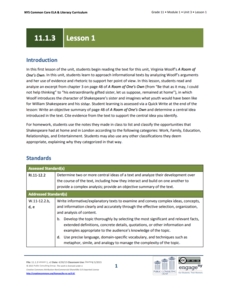Curated and Reviewed by
Lesson Planet
This Grade 11 ELA Module 1: Unit 3, Lesson 1 lesson plan also includes:
- EngageNY Resources (.html)
- Grade 11 ELA Module 1: Unit 3, Lesson 1 (.docx)
- Grade 11 ELA Module 1 Unit 3 Overview (.pdf)
- Grade 11 ELA Module 1 Unit 3 Overview (.docx)
- Grade 11 ELA Module 1 Unit 3 Lesson Text (.pdf)
- Grade 11 ELA Module 1 Unit 3 Lesson Text (.docx)
- Grade 11 ELA Module 1 Overview (.docx)
- Grade 11 ELA Module 1 Performance Assessment (.pdf)
- Grade 11 ELA Module 1 Performance Assessment (.docx)
- Grade 11 ELA Module 1 Performance Task (.pdf)
- Grade 11 ELA Module 1 Performance Task (.docx)
- Grade 11 ELA Module 1 Performance Assessment Rubric (.pdf)
- Grade 11 ELA Module 1 Performance Assessment Rubric (.docx)
- Grade 11 ELA Module 1 Performance Assessment Evidence Collection Tool (.pdf)
- Grade 11 ELA Module 1 Performance Assessment Evidence Collection Tool (.docx)
- Grade 11 ELA Module 1 Unit 3 Lesson 1 Central Ideas Tracking Tool (.pdf)
- Grade 11 ELA Module 1 Unit 3 Lesson 1 Central Ideas Tracking Tool (.docx)
- Grade 11 ELA Curriculum Map (.pdf)
- Grade 11 ELA Curriculum Map (.docx)
- Join to access all included materials
What was Shakespeare's youth like? Virginia Woolf considers the question in her nonfiction text, A Room of One's Own. Scholars begin reading Woolf's work before analyzing some of the text. Next, they write an objective summary and determine a central idea from page 48.
13 Views
5 Downloads
CCSS:
Designed
Concepts
Additional Tags
Instructional Ideas
- Provide background information about William Shakespeare and Virginia Woolf for added context
Classroom Considerations
- First part of eight from the Grade 11 ELA Module 1: Unit 3 series
- Each student requires a copy of A Room of One's Own by Virginia Woolf
Pros
- Incorporates reading, writing, and vocabulary practice
- Includes examples of what a high-performance writing response entails
Cons
- None



